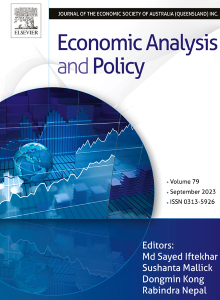能源行业市场与金融市场之间的极端时频关联性
IF 7.9
2区 经济学
Q1 ECONOMICS
引用次数: 0
摘要
可再生能源市场已发展成为一个独特的资产类别,受到全球投资者的高度关注。本研究调查了 S&P 500 指数与各种能源板块之间的关联性,包括绿色债券(Green Bond)、S&P GSCI 碳排放配额指数(GSCI EUA)、S&P GSCI 生物燃料(GSCI Biofuel)和 S&P 全球清洁能源指数(Global Clean Energy)。结合 Ando 等人(2022 年)的量化关联方法和 Chatziantoniou 等人(2022 年)开发的溢出指数,我们研究了这些市场之间的量化时间频率关联性。我们的研究结果表明,在极具挑战性的市场条件下,尾部风险扩散到能源行业的影响被显著放大。从频域分析来看,能源行业之间的尾部风险溢出大多涉及短期风险溢出。在极端情况下,尾部风险溢出的影响更大,显示出短期的不对称性。全球清洁能源和 S&P 500 指数在向其他行业扩散风险方面发挥着重要作用,即所谓的尾部风险溢出。它们增加了影响网络系统的整体风险。另一方面,其他能源板块(GSCI EUA 和 GSCI 生物燃料)以及绿色债券则作为净接受者,接受风险而不是进一步分散风险,从而有可能提供投资组合多样化。了解这些关键参与者如何影响金融体系的风险至关重要。利用各种技术评估投资组合的绩效表明,在制定投资组合的过程中,了解回报传导机制非常重要,并表明清洁能源由于其相对独立性,可能是一种极好的分散投资。本文章由计算机程序翻译,如有差异,请以英文原文为准。
Extreme time-frequency connectedness between energy sector markets and financial markets
The renewable energy market has developed into a distinct asset class that has garnered significant attention from investors worldwide. This study investigates the connectedness between the S&P 500 and various energy sectors, including the Green Bond (Green Bond), S&P GSCI Carbon Emission Allowances Index (GSCI EUA), S&P GSCI Biofuel (GSCI Biofuel), and S&P Global Clean Energy Indices (Global Clean Energy). Combining the quantile connectedness approach of Ando et al. (2022) and the spillover index developed by Chatziantoniou et al. (2022), we investigate the quantile time-frequency connectedness among these markets. Our findings reveal that the impact of tail risk spreading to the energy sector during extremely challenging market conditions is significantly amplified. Most tail risk spillovers between the energy sectors involve short-term risk spillovers, as seen by analyzing the frequency domain. The impact of tail risk spillover is stronger during extreme situations, showing a short-term asymmetry. Global Clean Energy and the S&P 500 play important roles in spreading risk to other sectors, known as tail risk spillover. They add to the overall risk that affects the network system. On the other hand, other energy sectors (GSCI EUA and GSCI Biofuel) as well as green bonds act as net recipients by receiving the risk rather than spreading it further, potentially providing portfolio diversification. It is essential to understand how these key players influence risk in the financial system. Utilizing a variety of techniques to assess portfolio performance shows the importance of understanding the return transmission mechanism in the process of developing a portfolio and suggests that Clean Energy, given its relative independence, may make an excellent diversification investment.
求助全文
通过发布文献求助,成功后即可免费获取论文全文。
去求助
来源期刊

Economic Analysis and Policy
ECONOMICS-
CiteScore
9.80
自引率
9.20%
发文量
231
审稿时长
93 days
期刊介绍:
Economic Analysis and Policy (established 1970) publishes articles from all branches of economics with a particular focus on research, theoretical and applied, which has strong policy relevance. The journal also publishes survey articles and empirical replications on key policy issues. Authors are expected to highlight the main insights in a non-technical introduction and in the conclusion.
 求助内容:
求助内容: 应助结果提醒方式:
应助结果提醒方式:


